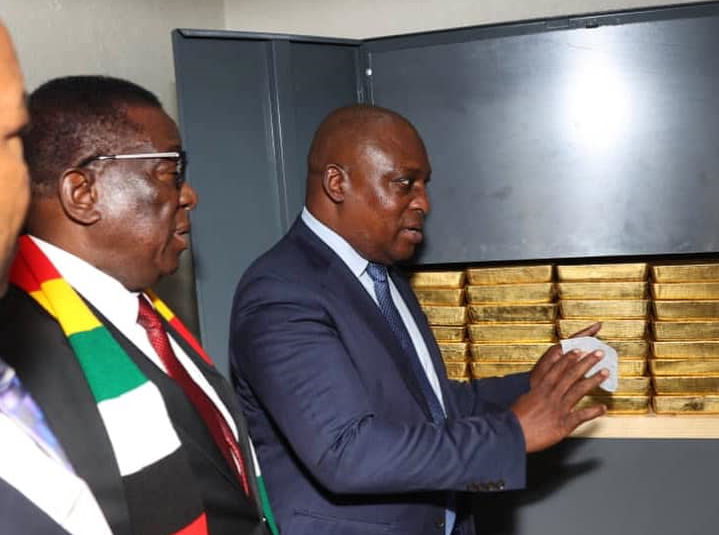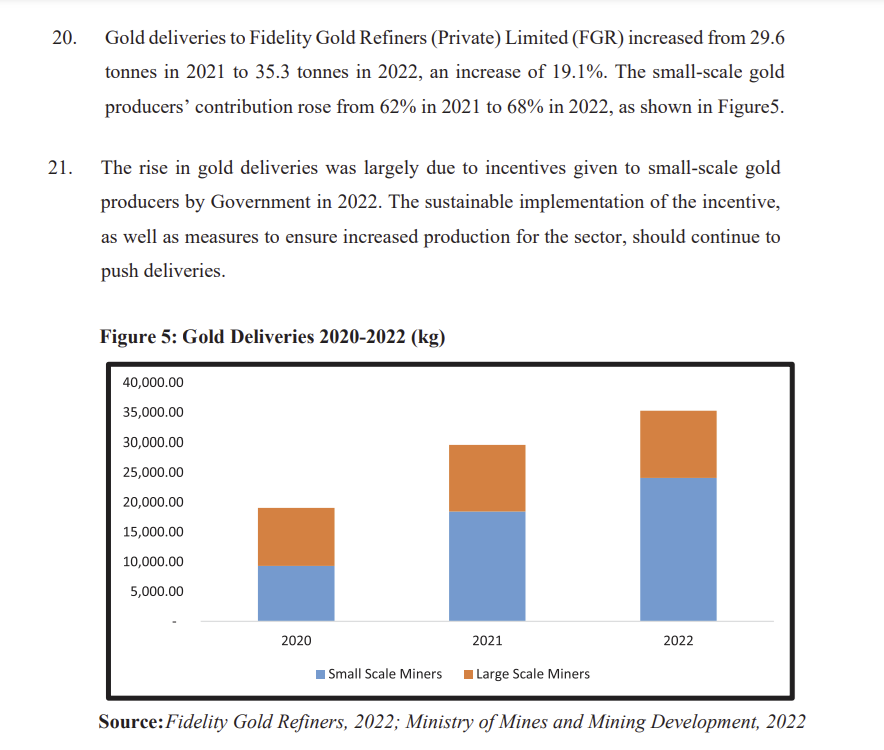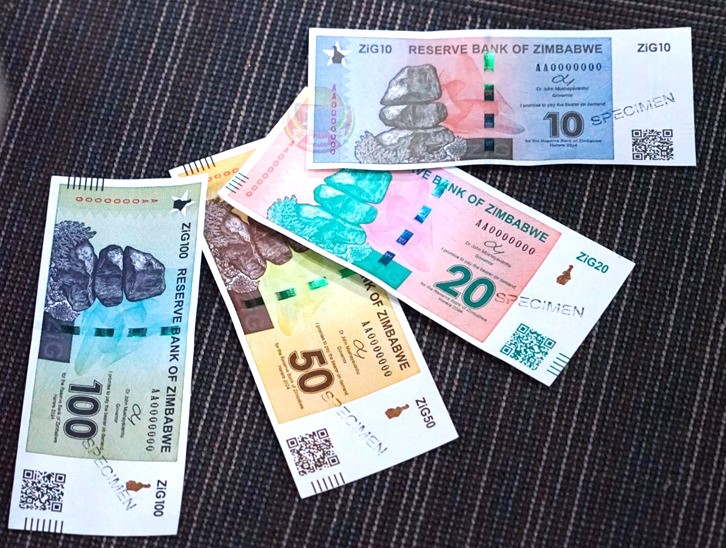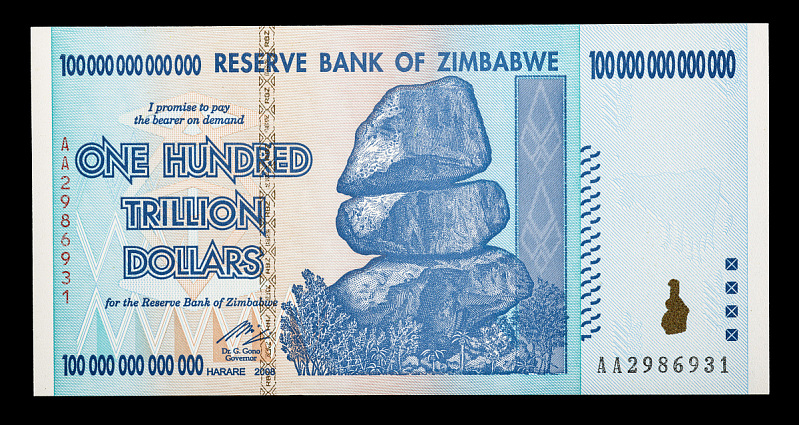Zimbabwe’s new gold-backed currency: Can the ZiG restore confidence and stability?
When the words ‘Zimbabwe’ and ‘currencies’ are mentioned in the same sentence, many people will bring to mind the chronic hyperinflation period that Zimbabwe experienced from the early 2000s to 2009, and the infamous 100 trillion Zimbabwean dollar note which Zimbabwe’s central bank issued in a desperate attempt to cope with that hyperinflation.
That hyperinflationary period – which included Zimbabwe’s inflation rate peaking at an astronomical 89.7 sextillion percent in November 2008 – was only brought under control when the country abandoned the then Zimbabwean dollar in 2009 and moved to a multi-currency system of officially using the US dollar and other foreign currencies, a move which stabilised Zimbabwe’s inflation rates at more ‘normal’ levels between the years 2010 and 2018.
But then in 2019, Zimbabwe introduced a new Zimbabwean dollar (ZWL), banned the use of foreign currencies, and began rampant ‘printing’ of the ZWL, a move which again torpedoed confidence in the country’s currency, destabilised the economy, and created spiralling levels of inflation from 2019 onwards, despite the backtracking reintroduction of foreign currencies such as the US dollar, as legal tender.
Backed by a Basket of FX Reserves and Gold
Which is why it’s very interesting that in early April 2024, Zimbabwe launched yet another new circulating currency as legal tender, its sixth attempt at creating a new currency since 2008, and the latest attempt to stabilise Zimbabwe’s economy and take control of a persistent inflation which in March 2024 had reached an annual rate of 55%.
However, this new currency, which is called the ZiG and which is issued in the form of circulating notes and coins, is quite different from preceeding currency attempts, as it bills itself as a gold-backed currency.
While colloquially being called a gold-backed currency, the new ZiG (which stands for Zimbabwe Gold) is more correctly, according to the legislation which launched it, a currency “backed by a basket of foreign currency reserves and precious metals (mainly gold) and valuable minerals held and maintained by the Reserve Bank [of Zimbabwe] in its vaults as part of the in-kind royalties.”
The ZiG is also known as a “structured” currency, which merely means that that it is backed or anchored by a basket of foreign exchange and gold, and linked to an exchange rate connected to the value of the backing. Under the rules of the ZiG, the Reserve Bank of Zimbabwe (RBZ) can only issue ZiG notes and coins against the value of the reserves assets which the central bank holds (foreign currency reserves and gold / precious metals held in its vaults).
At launch date on 5 April 2024, Zimbabwe’s commercial banks were required to convert all existing Zimbabwe dollar balances into the new ZiG currency, and as of that date, the ZiG became Zimbabwe’s legal tender (alongside the US dollar and other foreign currencies such as the South African rand, the Euro, and the pound sterling). Note that as of early April, the US dollar still accounted for about 85% of all transactions in Zimbabwe.
Currently, ZiG notes have been issued in denominations of 1, 2, 5, 10, 20. 50, 100 and 200 ZiG. On conversion date (5 April), 1 ZiG was deemed to have an equivalent value of 1 milligram of 99% pure gold valued at the spot price of gold on that day. The actual conversion (when banks converted all old ZWL account balances to ZiG) was done at the rate of ZiG 1 = ZW$ 2498.72 (ZWL).
Doing a quick spot check, 1 gram of gold at the close price on 5 April was US$ 74.91, and 1 milligram was US$ 0.07491, and the ZWL/USD rate was about 30530 ZWL for 1 US dollar, so this gives a conversion rate of (0.07491 * 0.99 * 30530) = 2264, which is pretty near the rate the bank used (and the FX rate was notoriously volatile during that time anyway).
With 1 Zig = (0.07491 * 0.99 = 0.0741609), that meant that 1 US dollar = ZIG 13.48. This is very near the ZiG 13.56 per US dollar quoted by Bloomberg in an article covering the subject on 5 April. But whatever way you look at it, you can see that at launch date, the value of the ZiG was connected to the gold price.
Going forward, the value of the ZiG is defined as “the inflation differential between ZiG and US dollar inflation rates, and the movement in the price of the basket of precious metals (mainly gold) and valuable minerals held as reserves by the Reserve Bank.” Again, the ongoing value of the ZiG is (at least in theory), related to the gold price.
Onshore and Offshore Gold
The RBZ claims, as of 5 April, to have held “reserve assets of USD 100 million in cash and 2,522 kgs of Gold (US$185 million)”, i.e. in total worth US$ 285 million. This US$ 285 million, said the RBZ, was more than 3 times cover for the total value of all ZiG currency which was converted and in issue at that time.

But beyond the headline claim that the RBZ hold 2,522 kilograms of gold (approximately 2.5 tonnes) in its vaults, this is in fact not totally accurate. As it turns out, the RBZ vaults in Zimbabwe’s capital Harare, hold 1.1 tonnes of gold. The RBZ also hold other precious metals including diamonds, which the RBZ says has an equivalent value of 0.4 tonnes of gold. That brings the total to 1.5 tonnes (of gold and gold equivalents).
The RBZ also says it holds an additional 1 tonne of gold ‘offshore’, but the location of this offshore gold has not been made public. This extar 1 tonne of offshore gold brings the total to the claimed 2.5 tonnes of gold.
As per a statement from the governor of the RBZ, John Mushayavanhu, on 5 April 2024:
“I can confirm that we have 1.1 tonnes of gold and other precious minerals in the form of diamonds which, if converted to gold, would equal 0.4 tonnes, making a total of 1.5 tonnes in our possession. We also have another tonne of gold held offshore. In total, when considering our gold reserves, we are talking about 2.5 tonnes, valued at about US$225 million, along with US$100 million in cash.”
According to the rules of the ZiG, the RBZ can only issue ZiG notes (and in the future ZiG coins) up to the value of the reserve assets which it holds, and the ZiG currency in circulation has to be fully backed by these reserve assets.
Insufficient Coverage? Insufficient Auditing?
Critics of the ZiG say that the value of the reserve assets at US$ 285 million does not provide sufficient import cover (being the equivalent of less than 2 weeks’ import cover for Zimbabwe’s imports). It is also less than 10% of the liquidity levels recommended by the South African Development Community (SADC)).
Hasnain Malaik of UAE based emerging market research firm Tellimer, quoted by Reuters, said that:
“Zimbabwe has an insufficient $285 million of hard currency and gold reserves. To fix the economy, Zimbabwe needs to address these root causes of its problems."
The Institute of Security Studies (ISS) also has no confidence in the ZiG and thinks the ZiG is doomed to failure, like its predecessors:
“Economic mismanagement has stripped citizens’ trust in the government and threatens the new currency’s viability. The recently introduced currency, ZiG, seems destined to suffer the same fate as the five previous attempts to create a local currency."
Admittedly, 2,522 kgs of gold (2.5 tonnes) does not sound like a lot, but Zimbabwe also aims to increase the country’s gold production and channel some of this gold to the central bank via in-kind royalties from mining companies. The RBZ also says that additional in-kind royalties from other precious metals and precious stones mined in Zimbabwe (such as platinum, lithium and diamonds) can be sold and reinvested into foreign exchange and gold. While Zimbabwe is within the list of top 10 gold producing countries in Africa, it’s in about eighth place behind bigger producers such as Ghana, Mali, South Africa Sudan, and Guinea.
“The ZiG currency is anchored to gold reserves. It then becomes very critical to ensure that we unlock the full potential of our gold resources, and of our gold sector" said Zimbabwean Mines and Mining Development Minister Winston Chitando during May. “Zimbabwe’s gold mining sector is targeting to raise production to 40 metric tons this year from 30.1 metric tons delivered last year."

As to verifying the existence of the gold that the central bank claims to hold as backing for the ZiG, the RBZ states that the reserve assets:
“shall be subject to independent audit not less frequently than once in a calendar year by external auditors specifically appointed for that purpose, and the results of the audit shall be published in the Annual Report of the Reserve Bank.”
Whether this relatively infrequent system of auditing is transparent enough to provide confidence in the ZiG remains to be seen.

Digital Currency and Gold Coins
This ZiG circulating currency is not the first time that Zimbabwe has experimented with a gold-backed currency to try to rein in inflation and stabilise the economy. In May 2023, Zimbabwe issued a gold-backed digital currency, which confusingly was also called ZiG, and in which the tokens of that digital currency could be used to pay for local transactions and which were “fully backed by physical gold” held by the Reserve Bank of Zimbabwe.
Now that ZiG refers to the new circulating currency launched in April 2024, the existing gold-backed digital currency have been rebranded as a Gold-backed Digital Token (GBDT).
In the third quarter of 2022, the Reserve Bank of Zimbabwe began issuing 1 oz 91.67% pure gold (known as Mosi-oa-Tunya gold coins), sold to both the retail public and corporates, with the coins minted by Fidelity Printers and Refiners, a security printing and gold refinery owned by the RBZ. Subsequently, ½ oz, ¼ oz and 1/10 oz weights of these gold coins were also minted. The rationale for issuing both the gold coins and gold-backed token was to provide Zimbabweans with a store of value and an alternative to the eroding value of the Zimbabwean dollar.
ZiG-Zagging and Flip Flopping
But on the ground and in the real economy in Zimbabwe, there is confusion, and distrust. This is not surprising due to decades of experience the population has had to face with hyperinflation, political corruption, a murky line between central bank independence and government interference, and the collapsing values of all previous Zimbabwean currency experiments. The experience on the ground seems to be one more of zig-zagging than ZiG. For example:
• It will be obligatory for companies to settle at least 50% of their tax obligations in ZiG, says the central bank.
• The government has ordered some government departments to only use the ZiG (and not US dollars), but other departments, such as Zimbabwe’s passport issuing office, will only accept US dollars.
• However, the government has granted exceptions to some private businesses, such as gas stations, allowing them to refuse to accept ZiG and only accept US dollars.
• Meanwhile, other private businesses are being forced to accept ZiG, and face fines is they don’t accept it.
• There is also a lack of public confidence in the ZiG. Some merchants refuse to accept it. Many people when they receive payments in ZiG immediately convert the ZiG to US dollars on the black market.
• In the first two weeks after the ZiG’s launch, the ZiG lost 50% of its value on the black market, falling from 1 US dollar = 13.56 ZiG to 1 US dollar being converted for more than 20 ZiG. This triggered Zimbabwe’s government to conduct mass arrests of black market money changers on the streets of Harare, with 65 dealers arrested. Unofficial currency dealers from now moved underground and conduct their business via Whatsapp.

Conclusion – Blame the World Bank
The rationale for introducing the ‘reserve asset’-backed ZiG has been to restore confidence in Zimbabwe’s currency, and in so doing, rein in high inflation and the previous depreciation of the Zimbabwean currency against major currencies such as the US dollar.
The choice of physical gold as a significant part of this reserve backing is understandable because gold is a stable store of value and wealth preservation, and the world’s pre-eminent monetary asset.
But like any currency, confidence is key, and while Zimbabwe’s government / central bank claims it will not finance government spending by printing money, if they break this promise and begin to print currency in excess of the value of the reserve assets backing the ZiG, confidence will evaporate, and the value of the ZiG will go the way of all previous Zimbabwean currencies, towards zero.
And the use of coercion in forcing Zimbabwe’s population to use the ZiG and not use the other ‘harder’ currencies like the US dollar, is an anti market competition tactic which will only push people further into using the FX black market.
On the surface this new ZiG currency looks like a domestic Zimbabwean invention, but there is evidence that international international institutions such as the International Monetary Fund (IMF) and World Bank are keeping a close eye, and have even been involved in its creation.
In May, the IMF said that “the introduction of ZiG represents an important policy action accompanied by several complementary policy changes — including monetary, exchange rate, and fiscal policy measures”, and this month in June 2024, the IMF is conducting an (Article IV) assessment of Zimbabwe’s economy where it hopes to “assess the entire economy as we always do, but also we will be looking at the new currency arrangement, the ZiG“.
According to an IMF spokesperson:
“Zimbabwe introduced a new currency backed by a basket of foreign currencies and other assets, including gold and of course we stand ready to discuss these with the authorities and to support their efforts to restore macroeconomic stability“.
But it’s the IMF’s sister organisation the World Bank, where things really get interesting, for astonishingly, the Reserve Bank of Zimbabwe governor John Mushayavanhu, has even pre-emptively laid the blame on the World Bank if the ZiG ends up failing, in April saying that:
“We didn’t know much about a structured currency. We got a consultant from the World Bank. A lot of the things you’re seeing about the structured currency actually came from the World Bank."
“So, if you’re going to blame me, you’re actually blaming the World Bank. Maybe they didn’t advise us properly. And if they did not advise us properly, it’s fine. Let’s refine it."
Not very inspiring words from a central bank head, are they?
In theory, the introduction of the ZiG is an interesting experiment in anchoring its value to a stable foundation of gold and foreign currency reserves. But with deep-rooted scepticism among Zimbabwe’s population in accepting the ZiG and a lack of confidence in the government’s transparency and economic management skills, the jury is still out on whether the ZiG will be a future case study of a successful new gold-backed currency, or a future case study of another basket-case to add to Zimbabwe’s long list of failed currencies.
Popular Blog Posts by Ronan Manly
 How Many Silver Bars Are in the LBMA's London Vaults?
How Many Silver Bars Are in the LBMA's London Vaults?
 ECB Gold Stored in 5 Locations, Won't Disclose Gold Bar List
ECB Gold Stored in 5 Locations, Won't Disclose Gold Bar List
 German Government Escalates War On Gold
German Government Escalates War On Gold
 Polish Central Bank Airlifts 8,000 Gold Bars From London
Polish Central Bank Airlifts 8,000 Gold Bars From London
 Quantum Leap as ABN AMRO Questions Gold Price Discovery
Quantum Leap as ABN AMRO Questions Gold Price Discovery
 How Militaries Use Gold Coins as Emergency Money
How Militaries Use Gold Coins as Emergency Money
 JP Morgan's Nowak Charged With Rigging Precious Metals
JP Morgan's Nowak Charged With Rigging Precious Metals
 Hungary Announces 10-Fold Jump in Gold Reserves
Hungary Announces 10-Fold Jump in Gold Reserves
 Planned in Advance by Central Banks: a 2020 System Reset
Planned in Advance by Central Banks: a 2020 System Reset
 Gold at All Time Highs amid Physical Gold Shortages
Gold at All Time Highs amid Physical Gold Shortages






 Ronan Manly
Ronan Manly 0 Comments
0 Comments










